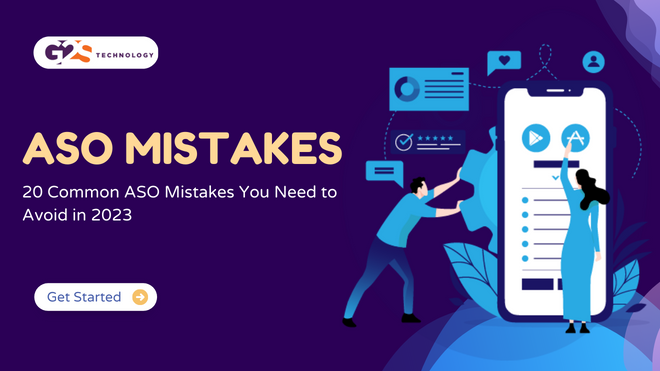Like SEO, App Store Optimization (ASO) has also evolved at a curtail.
New kinds of mobile apps and optimization techniques have been developed over a couple of years.
If you’re targeting ASO for greater visibility, high downloads, and app recognition, you must do all of the good things and by that means, you should avoid common ASO mistakes.
In this blog, I’ve highlighted the top ASO mistakes to avoid (as a beginner or intermediate) from a leading ASO Company In India that would help your app grow and be discovered.
List Of Common App Store Optimization Mistakes
ASO stands for App Store Optimization is the process of optimizing your app to rank higher in the app store search results, thus increasing visibility and downloads.
However, many developers make common ASO mistakes that can hinder their app’s success.
A list of twenty common ASO mistakes to avoid in 2023:
- Not Conducting Adequate Keyword Research
- Not Optimizing Your App Title
- Ignoring Your App Icon
- Not Writing a Compelling Description
- Ignoring Localization
- Not Utilizing Screenshots and Videos
- Not Optimizing Your App’s Size
- Ignoring User Reviews and Ratings
- Not Monitoring Your Competitors
- Not Utilizing Social Media
- Not Keeping Your App Updated
- Not Utilizing App Indexing
- Ignoring App Store Optimization Tools
- Not Conducting A/B Testing
- Ignoring User Behavior Metrics
- Not Having a Comprehensive ASO Strategy
- Not Prioritizing User Experience
- Ignoring Local Laws and Regulations
- Not Paying Attention to App Store Guidelines
- Not Utilizing Influencer Marketing
Now, read the detailed summary of each of the app store optimization mistakes below.
1. Not Conducting Adequate Keyword Research

It’s an important ASO mistake that 1 out of 5 people make.
Keywords play a critical role in ASO. Without proper keyword research, you won’t know what keywords your target audience is searching for.
Thus, it is essential to conduct adequate keyword research to identify relevant and high-traffic keywords. You can use tools like Google’s Keyword Planner, Sensor Tower, or App Annie to conduct keyword research. Use long-tail keywords and phrases to target specific search queries.
2. Not Optimizing Your App Title

Your app title is one of the most critical ASO elements. It should include your primary keyword and accurately describe your app’s purpose.
Keep your title short and memorable. Avoid stuffing it with keywords or using special characters as it can harm your app’s visibility.
3. Ignoring Your App Icon

Your app icon is the first impression that users will have of your app. It should be visually appealing and relevant to your app’s purpose.
Avoid using text or images that are too small or unclear. Keep it simple and recognizable, making it easy for users to identify your app.
4. Not Writing a Compelling Description

Another common ASO mistake that most early-age developers make.
Your app’s description should be informative and persuasive, highlighting the key features and benefits of your app.
Use bullet points, short paragraphs, and relevant images to make it easy to read.
Avoid using technical jargon and keep it concise. Highlight what sets your app apart from the competition.
5. Ignoring Localization

Localization is the process of adapting your app to different languages and cultures. Ignoring localization can limit your app’s reach to non-English speaking users.
Translate your app’s title, description, and keywords into the target language. Ensure that the translated content is accurate and culturally appropriate.
6. Not Utilizing Screenshots and Videos

Screenshots and videos are an effective way to showcase your app’s features and benefits visually.
Use high-quality images and videos that accurately represent your app’s functionality.
Use captions and annotations to explain the app’s features and benefits.
7. Not Optimizing Your App’s Size

App size is a crucial factor in ASO, especially for users with limited storage space. Optimizing your app’s size can improve user retention and app store rankings.
Use compression tools to reduce the size of your app’s assets. Remove unnecessary features and files to reduce the app’s overall size.
8. Ignoring User Reviews and Ratings

If you’re doing these ASO mistakes for a long time, you will surely get kicked out from ranking.
User reviews and ratings are significant factors in ASO. Ignoring or responding inadequately to user reviews can harm your app’s reputation and ranking.
Encourage users to leave reviews and respond promptly to feedback. Address negative reviews professionally and resolve user issues promptly.
Also read: 7 New (Unheard & Upcoming) Digital Marketing Trends In 2023
9. Not Monitoring Your Competitors

Monitoring your competitors’ ASO strategies can provide insights into what is working and what isn’t.
Analyze their app titles, descriptions, keywords, screenshots, and videos.
Identify areas where you can differentiate your app from the competition.
10. Not Utilizing Social Media

Social media can be an effective way to promote your app and engage with your target audience.
Use social media platforms like Facebook, Twitter, Instagram, and LinkedIn to promote your app’s features and benefits.
Share updates, screenshots, videos, and user reviews.
11. Not Keeping Your App Updated

Keeping your app updated can improve user experience and app store rankings. Regularly update your app’s features, fix bugs, and optimize performance.
Use user feedback to identify areas for improvement and make necessary changes.
12. Not Utilizing App Indexing

App indexing allows your app content to be indexed by Google and appear in search results.
Ensure that your app’s content is discoverable by search engines. Use deep links to direct users to specific app pages from search.
Also read: Biggest SEO Trends for 2023 and SEO Tips by Industry Expert
13. Ignoring App Store Optimization Tools

App store optimization tools can provide valuable insights into your app’s performance and areas for improvement.
Use tools like Sensor Tower, App Annie, or Mobile Action to monitor your app’s rankings, keyword performance, and user reviews.
Use this data to optimize your app and improve its visibility.
14. Not Conducting A/B Testing

App store A/B testing involves testing two different versions of your app’s ASO elements to determine which performs better.
Use A/B testing tools like StoreMaven or SplitMetrics to test different app titles, descriptions, keywords, and visuals.
Use the data to optimize your ASO strategy and improve your app’s performance.
15. Ignoring User Behavior Metrics

Your app’s user acquisition channels can impact your app’s visibility and success.
Utilize multiple channels to reach your target audiences, such as paid advertising, social media, content marketing, and influencer marketing.
Monitor the performance of each channel and optimize your strategy accordingly.
16. Not Having a Comprehensive ASO Strategy

In case you’re not defining a winning ASO strategy, you are making big ASO mistakes.
ASO requires a comprehensive strategy that involves optimizing all aspects of your app’s presence in the app store.
Neglecting any aspect of ASO can result in missed opportunities and lower app store rankings.
Develop a comprehensive ASO strategy that includes keyword research, app title optimization, visual elements optimization, user reviews management, and continuous optimization.
17. Not Prioritizing User Experience

User experience is a critical factor in ASO. A poorly designed app with a bad user experience can result in negative user reviews and low retention rates.
Prioritize user experience by designing an intuitive interface, optimizing app performance, and providing excellent customer support.
Also read: How App Reviews Can Grow Your App’s LTV and Lower CPI
18. Ignoring Local Laws and Regulations

Local laws and regulations can vary from region to region.
Ignoring local laws and regulations can result in your app being removed from the app store or facing legal consequences.
Research and comply with local laws and regulations before launching your app in a new region.
19. Not Paying Attention to App Store Guidelines

App store guidelines are put in place to ensure that all apps meet a certain standard.
Failure to comply with these guidelines can result in your app being rejected or removed from the app store.
Read and understand the app store guidelines for each platform and ensure that your app meets the requirements.
20. Not Utilizing Influencer Marketing

By not utilizing influencer marketing, you could be missing out on the opportunity to tap into a highly engaged and targeted audience that may be interested in your app.
Influencers can help create buzz around your app, increase brand awareness, and drive app downloads.
Final Thought
In summary, avoiding these 20 common ASO mistakes can significantly improve your app’s visibility, downloads, and overall success.
Conducting thorough keyword research, optimizing your app’s title and visual elements, utilizing app store optimization tools, and prioritizing user experience are all crucial components of a successful ASO strategy.
If you need professional consultation or guided advice on App Store Optimization, do connect with our expert.





